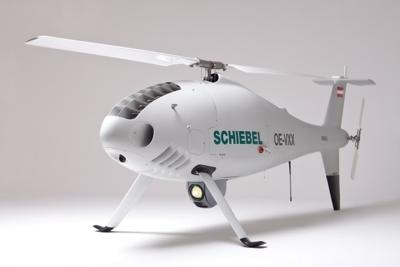Thu, Aug 28, 2014
Flying From Ship-Borne Migrant Offshore Aid Station
As part of the Migrant Offshore Aid Station operation the Schiebel Camcopter S-100 UAS (Unmanned Air System) is helping to save the lives of refugees in the Mediterranean Sea.

Desperate people fleeing conflict, economic desperation and violence in their homeland look towards Europe as a safe haven. They travel by all means possible for days or weeks on end to get to countries of transit from which they will sail out in makeshift sea craft. The lucky ones reach Europe where they can claim asylum, the unlucky ones perish.
MOAS was founded to take action to prevent such tragedies in the future and initiated Operation Phoenix where the Camcopter S-100 plays a vital role. A ship-borne aid station, named Phoenix, was made available to support refugee vessels in need. Phoenix has two 18-foot rigid inflatable boats on board that respond to calls for assistance.
The Camcopter S-100 is launched from on board the ship to locate and identify boats in distress. The UAS then provides imagery in real-time, day and night and even under adverse weather conditions. Operated by Schiebel personnel, the EO/IR camera submits essential data to locate people in need. With the help of the unmanned helicopter the Rescue Coordination Centre (RCC) can be informed and provide help immediately.
The mission radius was implemented in a strategic geographic location on the central Mediterranean route, affected by migratory flows departing from the southern Mediterranean littoral. Between August and October 2014, the 120-foot expedition vessel Phoenix will conduct three operations in central Mediterranean, each lasting two to three weeks.
“We are very happy to provide this capability and our experience for MOAS to help people in need," said Hans Georg Schiebel, Chairman of the Schiebel Group. "With our combined effort we can save the lives of refugees in the Mediterranean Sea and hopefully raise awareness for the situation of migrants worldwide.”
(Camcopter S-100 pictured in file photo)
More News
Pilot Also Reported That Due To A Fuel Leak, The Auxiliary Fuel Tanks Were Not Used On June 4, 2025, at 13:41 eastern daylight time, a Piper PA-23, N2109P, was substantially damage>[...]
Have A Story That NEEDS To Be Featured On Aero-News? Here’s How To Submit A Story To Our Team Some of the greatest new stories ANN has ever covered have been submitted by our>[...]
From 2023 (YouTube Edition): Reflections on War’s Collective Lessons and Cyclical Nature The exigencies of war ought be colorblind. Inane social-constructs the likes of racis>[...]
Aero Linx: Colorado Pilots Association (CPA) Colorado Pilots Association was incorporated as a Colorado Nonprofit Corporation in 1972. It is a statewide organization with over 700 >[...]
High Speed Taxiway A long radius taxiway designed and provided with lighting or marking to define the path of aircraft, traveling at high speed (up to 60 knots), from the runway ce>[...]
 NTSB Prelim: Piper PA-23
NTSB Prelim: Piper PA-23 ANN FAQ: Submit a News Story!
ANN FAQ: Submit a News Story! Classic Aero-TV: One Mans Vietnam
Classic Aero-TV: One Mans Vietnam ANN's Daily Aero-Linx (07.03.25)
ANN's Daily Aero-Linx (07.03.25) ANN's Daily Aero-Term (07.03.25): High Speed Taxiway
ANN's Daily Aero-Term (07.03.25): High Speed Taxiway



